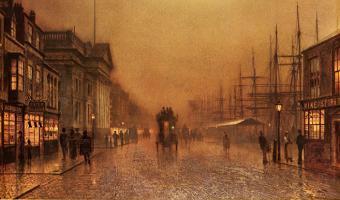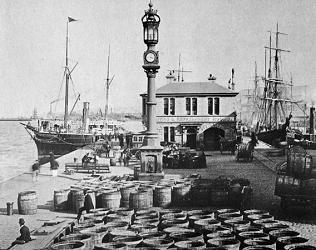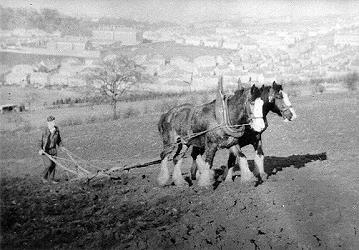 |
 |
| A contemporary painting giving something of the atmosphere of the Custom House Quay, Greenock, at night in the 1870s or 80s. | The Custom House Quay, Greenock in 1878. |
A Brief History of Greenock
as it relates to the McKechnie family history.
The Town of Greenock
This brief summary of Greenock's history is intended as a background to the McKechnie family history. It therefore concentrates on items considered relevant, and should not be regarded as a comprehensive history of the town.
Greenock (pronounced 'Green-ock' or 'Grin-ock', not 'Grenn-ock' as is commonly believed in England) is situated on the south bank of the River Clyde about 22 miles from Glasgow. It is thought that the original village of Greenock grew up around the chapel of St. Lawrence, which was situated at the west corner of the present Virginia Street, and of which traces remained until 1760.
The castle of 'Wester Greenock' was formerly located on the site of Well Park and was the residence of the Shaw family who exerted considerable influence on the development of the town. The Shaw family has a long connection with Greenock. In 1635 John Shaw obtained a charter from King Charles I which conferred upon Greenock the rights and privileges of a burgh of barony. Until 1741 the laird superintended the burghal affairs of Greenock. The feudal superior or by a baron-baillie appointed by him. As a result of a charter dated 30th January 1741 and another in the year 1751. Sir John Shaw gave power to the feuars and sub-feuars to meet annually for the purpose of choosing nine feuars residing in the town to be managers of the burgh funds.
The municipal government and jurisdiction of the town continued to be administered under the charter of 1751 until the Burgh Reform Act of 1833. As a result of that Act the Town Council began to consist of a provost, four bailies. a treasurer and ten councillors. Greenock continued to exist as a burgh until 1975, when the last provost demitted office as a result of the reorganisation of local government in that year, when Greenock became part of the District of Inverclyde within the Strathclyde region. In 1992, the population of Greenock was estimated to be 57,643.
 |
 |
| A contemporary painting giving something of the atmosphere of the Custom House Quay, Greenock, at night in the 1870s or 80s. | The Custom House Quay, Greenock in 1878. |
Shipbuilding
Shipbuilding in Greenock was formerly of great importance. In 1764 Peter Love built the first square-rigged vessel. This vessel was appropriately named the ‘Greenock’. In 1840 vessels were built with a total tonnage of 7,338 tons. During the years from 1875 to 1914 there was considerable development of the shipbuilding industry in Greenock. Tonnage figures had increased to 20,000 tons by 1876 and 52,744 tons by 1882. The industry was affected by the depression after the First World War, but in 1958 Greenock yards still built nine ships of a total gross tonnage of 60,015 tons. By 1990, the industry fad all but died.
Prominent persons in shipbuilding included John Wood (1788-1860), John Denholm (1853-1937), Sir James Lithgow (1883-1952), and John Scott (1830-1903).
Commerce
The development of Greenock as a port can be seen by the fact that the total tonnage of sailing vessels registered as belonging to Greenock increased from 29,054 tons in 1825 to 168,644 tons in 1881. The total tonnage of steamers rose from 2,012 tons in 1853 to 50,572 tons in 1881. The number of harbours in the town stood testimony to Greenock's importance as a major world port.
By the early 1880's a wide range of manufacturing companies had been established in the town and surrounding area. There were sail cloth factories, sail-making establishments, rope works, woollen factories, a flax mill, and a paper mill. There were also sawmills, grain mills, a large cooper work, a distillery, breweries, soap and candle works, a pottery, a straw hat manufacturer, and chemical works. A major industry was sugar refining, and there were many sugar refineries in the town, the last one closing in the late 1990s.
For a considerable period the people of Greenock were almost totally involved in the promotion of industry and commerce and literature and science suffered. This is evident in the case of the poet John Wilson, who was appointed as master of the grammar school of Greenock in 1769. A condition of his employment was, that he should abandon ‘the profane and unprofitable art of poem-making’.
Community
In 1830, the Mechanics' Institute was founded in buildings at the junction of Sir Michael Street and Tobago Street. By 1855 the institute provided a swimming bath, a reading room and a library, and organised a wide programme of lectures, concerts, educational classes and penny readings for working men. The institute's usefulness declined when the town council opened its own facilities such as the free public library in the early 1900s.
In the early 19th century, the influx of workers for Greenock's expanding industries was not matched by the building of adequate housing. By 1850 things were getting desperate, and the new development started in the East of the town. Belville Street provided examples of the tenement properties being built at the time, and was situated on the hill overlooking the shipyards and the river.
 |
|
| John McKechnie ploughing above Cowdenknowes in the 1940s. The large building in the centre is the prison, and Wallace Street would be in the right background. |
During the 1920s and 1930s, Greenock saw the same industrial depression and rise in militarism as the rest of Britain and Europe. Flag-waving and parades were common, and the churches held open-air "Drumhead Services" as a popular form of worship. The drum service was conducted by a church minister, with drums arranged as a lecturn or pulpit, possibly imitating military practice.
New housing continued to be built during this period, widening the boundaries of the town along the Inverkip Road, including Wallace Street in the Cowdenknowes development. Each new housing development meant one less farm!
The Press
The ‘Greenock Advertiser’ was the first newspaper to be published in the town in 1802. The ‘Greenock Herald’ commenced publication in 1852. The ‘Greenock Telegraph’ was founded in 1857, and continues to be published at the present time. It was the first halfpenny evening daily paper in Britain.
Greenock developed in the 19th century as a sea port, with the associated industries of ship-building, and manufacturing from the imported raw materials using the plentiful water in the surrounding hills. By the end of the 20th century shipbuilding, sugar refining and manufacturing had all but gone, making way for the new industries of electronics, computers, and microchips. Greenock's importance as a sea port has declined, and steamers no longer calling at the now demolished Princes Pier, which has been replaced by a Container Terminal with container and timber ships calling occasionally.
To our arm of the McKechnie and Peden families, Greenock was home for almost a century, between the 1860s and the 1960s. Coming from the subsistence farms of the Highlands and Ireland, Greenock provided regular employment, improved living conditions and the education that was becoming more necessary in the developing world. Today's family members, in Scotland, England, and elsewhere in the world, can thank Greenock for helping get them where they are today!